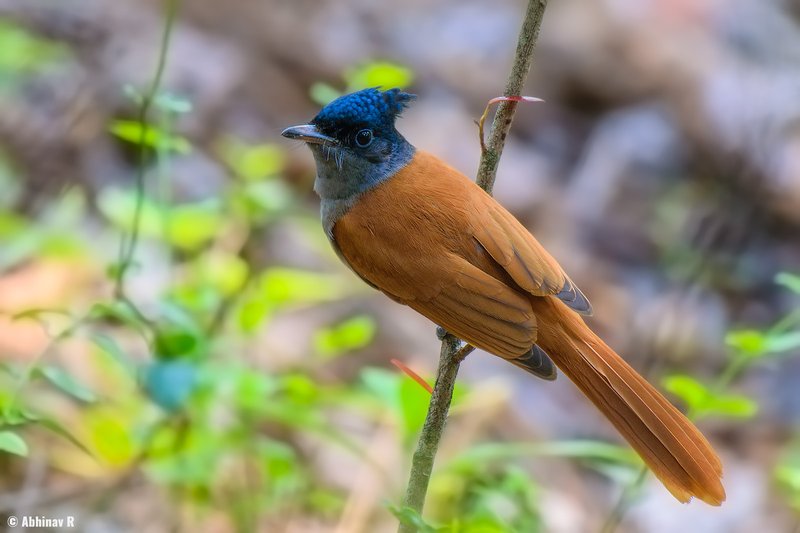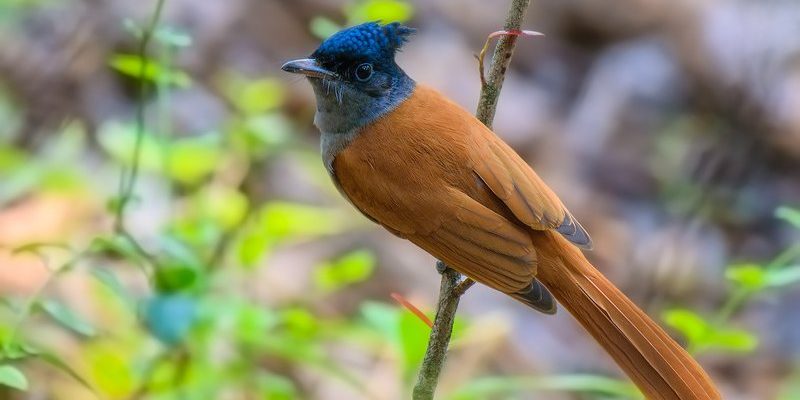
The Indian Paradise Flycatcher is a bird that’s hard to forget, largely due to its stunning appearance and charming behavior. Imagine seeing a bird with long, flowing tail feathers that seem to dance in the breeze. These striking features not only captivate birdwatchers but also play a role in their mating rituals. If you’re a nature enthusiast or just curious about wildlife, the Indian Paradise Flycatcher undoubtedly deserves a place on your list of must-see birds.
Found in the forests and woodlands of the Indian subcontinent, this bird is more than just a pretty face. It has a fascinating lifestyle filled with unique behaviors, from the way it hunts for insects to its enchanting calls. Learning about these aspects can deepen your appreciation for this exquisite creature. So, let’s dive into the world of the Indian Paradise Flycatcher and explore what makes it so special!
Physical Characteristics
When you first lay eyes on an Indian Paradise Flycatcher, you might be struck by its exceptional looks. The males typically boast a brilliant white plumage with striking black markings on their head, while the females are more subdued, sporting a warm brownish color. The most remarkable feature is their long, elegant tail feathers that can be over a foot long. These tails are not just for show; they play a crucial role during courtship displays, where males flaunt their beauty to attract females.
The striking coloration and impressive size make this bird a favorite among photographers and birdwatchers alike. Besides their visual appeal, their nimble flight patterns are equally captivating. They have a powerful and agile flight style, zipping through the air to catch insects mid-flight. Their ability to maneuver quickly helps them evade predators and catch their favorite meals.
Habitat and Distribution
The Indian Paradise Flycatcher is found predominantly in the Indian subcontinent, with its habitat stretching across various regions, including India, Nepal, and parts of Sri Lanka. They thrive in mixed deciduous forests, open woodlands, and even in gardens, as long as there are ample trees and shrubs. These environments provide not only food but also shelter for nesting. The flycatcher prefers areas that allow for easy hunting of insects, which is an essential part of its diet.
This bird is migratory in certain regions, with some populations moving to lower altitudes during the winter months. So, if you’re in an area where they reside, you might get lucky and spot them during the migration season. During the breeding season, males become particularly visible, establishing territories and engaging in elaborate courtship displays to woo females.
| Common Name: | Indian Paradise Flycatcher |
| Scientific Name: | Terpsiphone paradisi |
| Size: | 23-30 cm (9-12 inches) |
| Weight: | 20-30 grams (0.7-1.1 ounces) |
| Diet: | Insects, small fruits |
| Lifespan: | 3-5 years in the wild |
Behavior and Diet
The Indian Paradise Flycatcher is a skilled hunter, primarily feeding on insects. You might see this bird darting through the trees, often catching its prey mid-air and displaying impressive agility. They can also forage from branches, picking insects off leaves or snagging them from flowers, showing their versatility in feeding. Although insects make up the bulk of their diet, they do enjoy fruits, especially during the breeding season when they need extra energy.
Behaviorally, these birds exhibit interesting patterns. Males are known for their elaborate courtship displays, which can include dramatic aerial acrobatics. They often sing beautiful melodies that echo through the forest, adding to their charm. If you’re in their territory, you might hear a series of melodious notes that sound almost like a soft song, enticing you to search for their source.
Nesting and Reproduction
When it comes to nesting, Indian Paradise Flycatchers are quite particular. The female builds a small cup-shaped nest, usually high up in a tree, using twigs, leaves, and spider silk to bind it all together. This strategic placement helps protect the young from predators. The female typically lays around 2-4 eggs, which she incubates for about two weeks. During this time, the male stays close, providing food and guarding the territory.
Once the eggs hatch, both parents are involved in feeding and caring for the chicks. The young birds fledge about two weeks after hatching but remain dependent on their parents for a while longer. Watching a family of Indian Paradise Flycatchers can be quite a treat for nature lovers, providing a glimpse into the joys and challenges of avian parenting.
Conservation Status
Currently, the Indian Paradise Flycatcher is not considered endangered, but like many species, it faces threats from habitat loss due to deforestation and urbanization. Conservation efforts are vital to ensure that this stunning bird continues to thrive in its natural habitat. Many organizations work towards preserving forest areas while raising awareness about the importance of biodiversity.
As individuals, we can contribute to conservation by supporting local wildlife initiatives and practicing responsible tourism. Every little action counts when it comes to protecting the delicate balance of ecosystems that support not only the Indian Paradise Flycatcher but countless other species as well.
Fun Facts
The Indian Paradise Flycatcher comes with its fair share of fascinating tidbits. For starters, these birds are known for their distinctive vocalizations, which can vary significantly depending on their region. Each dialect can give insight into their adaptability and communication.
Additionally, the Indian Paradise Flycatcher is often featured in various cultural symbols and literature, emphasizing its beauty and significance in the natural world. Their captivating appearance and graceful flight make them a symbol of elegance and freedom in many traditions.
In wrapping up our exploration of the Indian Paradise Flycatcher, it’s clear that they are much more than just a beautiful bird. From their stunning looks to their intriguing lifestyles, they remind us of the wonders of nature that surround us. If you ever get the chance to observe one in the wild, take a moment to appreciate the beauty and complexity of their existence. Nature has a way of captivating and inspiring us, and the Indian Paradise Flycatcher does just that.
FAQ
Where can I find the Indian Paradise Flycatcher?
You can spot the Indian Paradise Flycatcher in various habitats across the Indian subcontinent, particularly in mixed forests, open woodlands, and gardens. They are often seen during the breeding season, making it a great time for birdwatchers to catch a glimpse of these magnificent birds.
What does the Indian Paradise Flycatcher eat?
This bird primarily feeds on insects, which it catches in mid-air or picks off leaves. In addition to insects, they may also consume small fruits, especially during breeding season when they need extra energy for nesting and caring for their young.
How do Indian Paradise Flycatchers reproduce?
The female Indian Paradise Flycatcher builds a small, cup-shaped nest high up in trees. She usually lays 2-4 eggs and incubates them for about two weeks. After hatching, both parents participate in caring for the chicks until they are ready to fend for themselves.
Are Indian Paradise Flycatchers migratory?
While not all populations of the Indian Paradise Flycatcher are migratory, some do move seasonally to seek warmer climates during winter. This behavior can vary based on local environmental conditions and food availability.
What is the lifespan of an Indian Paradise Flycatcher?
In the wild, an Indian Paradise Flycatcher typically lives for about 3-5 years. However, factors like predation, habitat loss, and food availability can influence their lifespan significantly.
Why are Indian Paradise Flycatchers important to their ecosystem?
Indian Paradise Flycatchers play a crucial role in their ecosystem as insectivores. By feeding on insects, they help control insect populations, which can affect the health of plant life. Their presence also indicates a healthy ecosystem, making them important for biodiversity.
Can Indian Paradise Flycatchers be kept as pets?
While they are beautiful and fascinating birds, Indian Paradise Flycatchers are wild animals that thrive best in their natural habitats. Keeping them as pets can be detrimental to their well-being and is generally not recommended. Instead, enjoy observing these birds in their wild environments.
How can I help conserve Indian Paradise Flycatchers?
You can support efforts to conserve Indian Paradise Flycatchers by promoting habitat preservation, supporting local conservation organizations, and being mindful of your ecological footprint. Educating others about the importance of biodiversity can also help raise awareness and encourage protective measures.
Do Indian Paradise Flycatchers have any predators?
Like many birds, Indian Paradise Flycatchers face threats from various predators, including larger birds of prey and snakes. Their nesting sites are often chosen to minimize exposure to these threats, but they still must remain vigilant to protect themselves and their young.
What adaptations help the Indian Paradise Flycatcher survive?
The Indian Paradise Flycatcher has several adaptations that support its survival, including its sharp eyesight for spotting prey and its remarkable flight skills for catching insects. Their vibrant plumage also plays a role in mating, helping attract potential partners during the breeding season.

